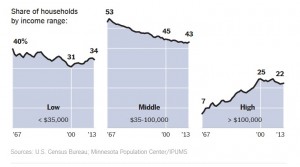Dear Commons Community,
This has been a rough two weeks in Albany, New York, that started with the arrest of the Assembly Speaker Sheldon Silver. The faith of the people in their state political leaders has been terribly shaken. The New York Times editorial today calls for reform at all levels starting with Governor Cuomo who curtailed an ethics investigation last spring. Here is an excerpt. The full editorial is below.
“Now that Sheldon Silver has been pressured into agreeing to resign as speaker of New York’s Assembly after his arrest on corruption charges, the governor and the lawmakers who so poorly represent the state should not kid themselves into thinking they have made real progress on cleaning up what the federal prosecutor who indicted Mr. Silver called the “cauldron of corruption” in Albany.
In theory, the Democrats who control the Assembly should be able to pick a successor who is committed to good governance and ethics reform, but already the signs of back-room dealing and meddling from party hacks are not encouraging. And even a good choice would not be enough. Without real change, New York’s lawmakers could simply continue to rob the public of more than money, as the United States attorney for the Southern District of New York, Preet Bharara, said recently. These lawmakers cheat New Yorkers of the honest and productive representation they need and deserve.
If this is not the moment for change, then when?
Gov. Andrew Cuomo needs to lead the way, to turn his abstract promises of reform into tough laws that make a difference…
The ethics police in Albany have been rendered powerless by the lawmakers who created them. The Joint Commission on Public Ethics is unwieldy and unable to proceed with an investigation if the members appointed by the Legislature veto it. Another group, the Legislative Ethics Commission, does little more than dispense advice. The New York Public Interest Research Group last week proposed a merger of the two, and urged greater independence. Until then, New Yorkers will have to rely on outsiders like Mr. Bharara for ethics policing.”
Such a sad situation for our state!
Tony
——————————————-
New York’s Cauldron of Corruption!
New York Times Editorial Board
January 30, 2015
Now that Sheldon Silver has been pressured into agreeing to resign as speaker of New York’s Assembly after his arrest on corruption charges, the governor and the lawmakers who so poorly represent the state should not kid themselves into thinking they have made real progress on cleaning up what the federal prosecutor who indicted Mr. Silver called the “cauldron of corruption” in Albany.
In theory, the Democrats who control the Assembly should be able to pick a successor who is committed to good governance and ethics reform, but already the signs of back-room dealing and meddling from party hacks are not encouraging. And even a good choice would not be enough. Without real change, New York’s lawmakers could simply continue to rob the public of more than money, as the United States attorney for the Southern District of New York, Preet Bharara, said recently. These lawmakers cheat New Yorkers of the honest and productive representation they need and deserve.
If this is not the moment for change, then when?
Gov. Andrew Cuomo needs to lead the way, to turn his abstract promises of reform into tough laws that make a difference. Legislators who stand in his way can no longer hide behind the well-worn tricks used by the likes of Mr. Silver and other leaders in Albany to avoid accountability and real change.
What’s at issue is the present and future governance of a state with nearly 20 million people and a budget of $150 billion, which is larger than that of many nations, including Finland, Venezuela and Egypt. The state’s 214 lawmakers not only influence the way people live across the state, but they have a chokehold on taxes, development, traffic and even education in New York City.
Over the last decade, more than 30 state officials have gone to prison or been accused of sexual or civic wrongdoing ranging from bribery to stealing state money and extortion. The group of 30 includes several lawmakers accused of sexual harassment. One governor resigned in scandal, a comptroller — the watchdog of the public purse — was jailed for fraud.
Of Albany’s many ethical problems, here are the three most urgent. In each case, we offer an ideal, long-term solution and a short-term “until then” fix.
Outside Income
Mr. Silver is accused of using his law practice to rake in millions of dollars while helping clients in Albany. It’s hard to imagine lawmakers voluntarily giving up all outside income, except, say, lecture fees, although that would be the ideal outcome. Governor Cuomo has proposed a commission that would recommend a two-tiered salary scale — one for full-time legislators and another for those with outside income. This could take forever. Short term, the Legislature should consider a bill offered by State Senator Brad Hoylman, a Manhattan Democrat, that would cap outside income at 15 percent of official salary, much as Congress does. Income should be documented in detail, including the amounts and the names of clients for legislators who are lawyers.
Campaign Finance
The charges against Mr. Silver make it scandalously clear how easy it is to buy influence in Albany. The campaign finance system needs a complete overhaul, with lowered limits, more disclosure and public matching funds for campaigns. Until then, lawmakers could end the scam used by many contributors to get around the few limits New York State law does have; they create dozens of small limited-liability corporations that can each give the maximum amount allowed. That was the method prosecutors say was used by Leonard Litwin, the real estate developer, whose company, Glenwood Management, funneled more than $10 million to candidates and party committees, including substantial funds to Mr. Silver.
Oversight
The ethics police in Albany have been rendered powerless by the lawmakers who created them. The Joint Commission on Public Ethics is unwieldy and unable to proceed with an investigation if the members appointed by the Legislature veto it. Another group, the Legislative Ethics Commission, does little more than dispense advice. The New York Public Interest Research Group last week proposed a merger of the two, and urged greater independence. Until then, New Yorkers will have to rely on outsiders like Mr. Bharara for ethics policing.
In his State of the State speech last week, Governor Cuomo spent only 80 seconds on the need to “restore the public’s trust.” He mentioned, in passing, the public financing of campaigns and the issue of outside income. With the arrest and resignation of Mr. Silver, restoring public trust should be at the top of Mr. Cuomo’s agenda.









